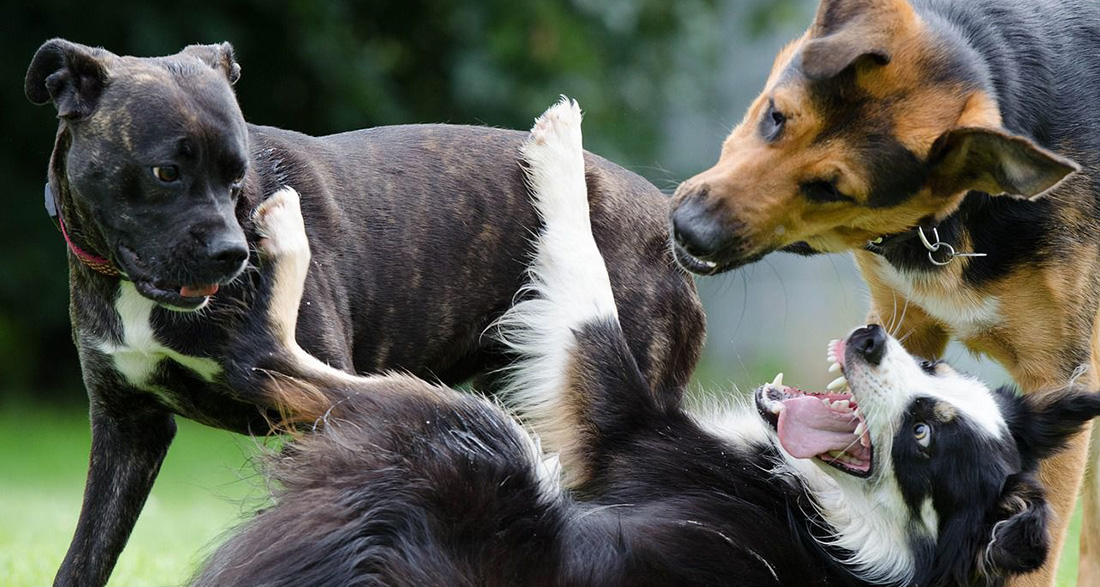Dogs standing perpendicular to each other seem to be communicating something through this position. Sometimes nothing happens, but in other situations, the animals may suddenly engage in conflict. The dog guide explains what the T-position in dogs means and why it can be useful in training.
Unlike humans, dogs primarily communicate nonverbally through their body language. Small changes in posture, such as the position of the tail, are clear signals for animals.
The T-position describes the alignment of two dogs to each other, resembling the letter “T.” However, the meaning of the T-position in dogs can only be understood through additional physical signals and the current situation.
In dog training, it is advantageous for owners to understand the dog’s signals and provide training assistance through their own body language. If the command contradicts the owner’s body posture, it can be confusing for dogs, and the desired reaction may not occur.
Understanding the T-position in dogs correctly can be beneficial in dog training.
Understanding the T-position in dogs
To understand the body language of dogs correctly, it is essential to consider not only the posture and position of the animals but also the entire situation. It requires some practice and experience because dogs communicate rapidly.
Similar to a dog’s wagging tail, the T-position between two animals can have various meanings, which are explained in more detail below.
- Protective T-position:
Dogs use the protective T-position to shield one or more insecure dogs, such as puppies, while they are eating.
- Defensive T-position:
Assertive dogs adopt the defensive T-position to avoid interaction with other dogs. It is a clear presence that requires neither dominance nor offensive behavior.
- Offensive T-position with eye contact:
Through an offensive T-position with eye contact with the other dog, the animals demonstrate their own strength. It can also be a sign to clarify their boundaries. The offensive T-position stops and blocks other animals in their movement. Insecure dogs or those with little contact with others often display this gesture and body language, leading to escalated dog encounters.
- Submissive T-position:
Dogs show affection by sliding under the head-neck area of another dog and remaining in this submissive T-position. If both dogs remain calm, and their body postures are relaxed, it is a harmless form of contact.
- T-position before mounting:
A female in heat or a male ready for reproduction signals their readiness through the T-position. Among males, the T-position is a sign of dominance.
- Playful T-position:
The T-position in dogs can be interpreted as a playful invitation when the animals stand perpendicular to each other, or one lies perpendicular to the other, with one placing its chin on the other’s neck. Sometimes, one may grab the other’s neck fur or nudge their shoulder.

Recognizing and using the T-position from dog to human
When dogs stand in the T-position with familiar people, it can be a friendly signal or a form of control. With strangers, it is a boundary-setting gesture intended to displace the other person.
Dog owners should be aware of the difference to prevent the dog from perceiving itself as the dominant part of the relationship. It is essential to ensure that the dog does not unintentionally limit its freedom of movement or hinder contact with other people and dogs. More on this topic under “Caution when Fido acts like the pack leader.”
In the T-position, the dog stands perpendicular to the owner and sometimes leans against their leg. This position is also possible while sitting, with the dog placing its head on the owner’s legs or feet.
Dog owners can also use the T-position themselves to stop the dog’s movement. This can be useful to prevent the dog from continuing to walk when the owners briefly stop during a walk. If one wishes to stand still during the walk, it is not advisable to do so with eyes and body facing forward. Instead, it is more sensible to stand perpendicular to the dog, blocking its movement. The whole process can then be completed with a command like “Sit” and rewarded upon successful execution.
The strength of the owner’s positioning against the dog depends on the sensitivity of the canine. Some dogs react very quickly to the slightest movements, while others require clearer gestures for understanding.

It is helpful to observe one’s own dog in interaction with other animals and people to assess its reactions to body language signals.


